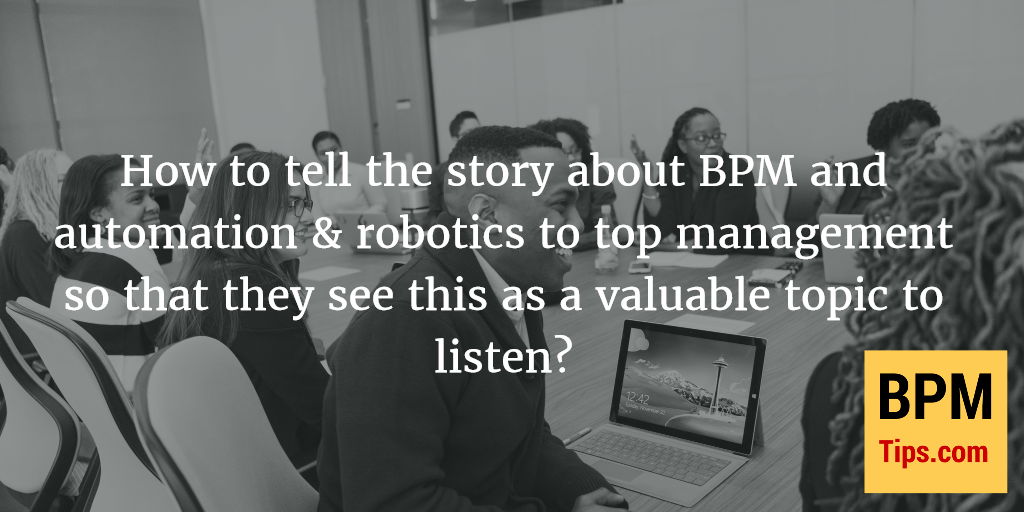After publishing the post about RPA I got many comments from readers. One of them asked about very interesting topic: how to make executives interested in the process automation. So, I decided to make a follow up (mini) post with good practices on this topic.
If you want to have a broader view on RPA and BPM take a look at the original post. It has insights from 30+ experts about the process automation. You can also download it at the bottom of this page.
There’s also a great post by Jim Sinur “Are Bots the Second Coming of BPM?“.
The question my reader asked was: “How to tell the story about BPM and automation & robotics to top management so that they see this as a valuable topic to listen?”

Below you can find the answers. You can either read everything or use the navigation below.
Ying Chen
Adam Devine
Michael Heffner
Dave Marcus
Wallace Oliveira
Bart Peluso
Alex Rawlings
Brian Reale
Mihir Shukla
Phil Simpson
Shik Sundar
Miguel Valdes Faura
Neil Ward-Dutton
Ying Chen (Pegasystems)
 As the Head of Product Marketing for the Pega 7 Platform, Ying Chen leads the strategy, positioning, and go to market for Pega’s industry recognized platform for digital transformation. Ying comes to Pega with more than 10 years of software product management experience leading Fortune 1000 organizations and VC-backed startups with varying software development methodologies to deliver award winning product solutions and enabling enterprises to make the leap from water fall to Agile. Ying holds an MBA from Boston University Graduate School of Management and a Bachelor of Science from Carnegie Mellon University.
As the Head of Product Marketing for the Pega 7 Platform, Ying Chen leads the strategy, positioning, and go to market for Pega’s industry recognized platform for digital transformation. Ying comes to Pega with more than 10 years of software product management experience leading Fortune 1000 organizations and VC-backed startups with varying software development methodologies to deliver award winning product solutions and enabling enterprises to make the leap from water fall to Agile. Ying holds an MBA from Boston University Graduate School of Management and a Bachelor of Science from Carnegie Mellon University.
WWW: https://www.pega.com
WWW: LI profile
Twitter: @yingchen42
Twitter: @pega
How to tell the story about BPM and automation & robotics to top management so that they see this as a valuable topic to listen?
Don’t start with the technology, start with the value that will be created. For example, RPA by nature lends itself to quick wins and rapid value creation when you focus the impact on automating small % of work rather than 100% of the work. Tasks like searching, rekeying, verifying, conforming (manual knowledge guidance), repetitive applying of the rules, signing in to multiple systems, and keeping pace with changing rules are all great examples of automations that yield rapid ROI that are non-invasive.
Build your story around how starting with RPA, you can fund additional automation projects to drive even more transformative productivity and cost savings. This allows you to leverage the ROI from RPA to parallel the codification of those automations on a case management platform, eliminating redundant tasks and optimize inefficient applications. This is important as the more automations you build, the ability to effectively create and manage the business rules and having access to a platform that already has proven capabilities to ensure enforcement and compliance will be key to complete your automation strategy business case. Make sure your story doesn’t end with a tactical conclusion by talking only about RPA – which is fairly focused on tactical execution. Ensure you provide a tactical to transformation path that allows the organization to pivot into different focus areas as you mature your transformation journey. Remember, the RPAs you create today might become redundant tomorrow when you’ve had the opportunity to streamline your operations and improve your engagement.
Adam Devine (WorkFusion)
 Adam leads market development, product and brand marketing, and strategic partnerships. He began his career in management consulting in the Financial Institutions Group at BearingPoint and has spent the past 14 years in tech product marketing and advertising. He was most recently director of strategy at 360i.
Adam leads market development, product and brand marketing, and strategic partnerships. He began his career in management consulting in the Financial Institutions Group at BearingPoint and has spent the past 14 years in tech product marketing and advertising. He was most recently director of strategy at 360i.
Adam holds a bachelor degree from the University of Vermont.
WWW: http://www.workfusion.com
WWW: LI profile
Twitter: @Devineous
Twitter: @workfusion
How to tell the story about BPM and automation & robotics to top management so that they see this as an valuable topic to listen?
If you’re a C-level executive, which would you rather see your business invest in: a 5-year, $10 million custom integration project that starves your entire business of IT resources for its entire duration and may or may not deliver intended results, or a 1-year adoption of intelligent automation software that puts the power of transformation on LOB leaders already working to improve service delivery? It’s a total no-brainer. RIP custom integration. Long live automation!
Michael Heffner (Appian)
 Mike Heffner leads Appian’s Financial Services practice globally, with an industry team that partners with FS firms to enable their digital transformations. Mike brings over twenty years of experience driving innovative approaches to problem solving within banking and capital markets. Prior to Appian, he was Managing Director, Business Transformation at State Street Global Markets, and also held management roles at Charles Schwab & Co., and Accenture. Mike holds BSBA in Economics from University of South Carolina, and an MBA from Babson College.
Mike Heffner leads Appian’s Financial Services practice globally, with an industry team that partners with FS firms to enable their digital transformations. Mike brings over twenty years of experience driving innovative approaches to problem solving within banking and capital markets. Prior to Appian, he was Managing Director, Business Transformation at State Street Global Markets, and also held management roles at Charles Schwab & Co., and Accenture. Mike holds BSBA in Economics from University of South Carolina, and an MBA from Babson College.
WWW: https://www.appian.com
WWW: LI profile
Twitter: @jet_tag
Twitter: @appian
How to tell the story about BPM and automation & robotics to top management so that they see this as an valuable topic to listen?
Robotic Process Automation (RPA) has emerged as a cost-effective technique to get work done. As RPA software “bots” automate high-volume, repeatable tasks within existing processes, they free efforts and enable attention to higher-value digital interactions that build relationships and trust while expanding revenue opportunities.
Extracting value from automation often entails redesigning entire processes; not just automating individual components of the process but rather implementing end-to-end renewal.
With the advent of RPA, financial services executives should reconsider how they manage digital process automation and supporting information technology. Benefits of improved accuracy, cycle time, and process productivity are best realized by those who take a strategic approach to integrating RPA into an overall automation architecture for digital transformation.
For mortgage origination, McKinsey estimates that “Automation could cut the current process time in the United States from an average 37 days to less than 1, which not only cuts costs but eliminates errors, reduces defaults, raises customer satisfaction, and lowers drop-out rates.” [McKinsey Quarterly, July 2017, A CEO Action Plan]
To maximize your results with RPA, apply these three best practices and ensure your technology partners work with you to achieve the anticipated results:
1. Stop Thinking Tasks; Start Thinking Results
2. Focus on the Customer Journey
3. Integrate for a One Risk ViewExcerpt from the report “Robotic Process Automation The Path To Digital Value For Financial Services Institutions” quoted by permission of Michael Heffner.
Dave Marcus (K2)
 As SVP of Strategic Alliances and Corp Development for K2, Dave’s time is focused on technology partnerships and alliances that drive ongoing value for K2 customers and accelerated innovation. Before joining K2 in 2007, Dave spent 14 years at Microsoft in a range of product groups and business divisions, both in South Africa and at Microsoft’s headquarters in Redmond, Washington, just outside of Seattle.
As SVP of Strategic Alliances and Corp Development for K2, Dave’s time is focused on technology partnerships and alliances that drive ongoing value for K2 customers and accelerated innovation. Before joining K2 in 2007, Dave spent 14 years at Microsoft in a range of product groups and business divisions, both in South Africa and at Microsoft’s headquarters in Redmond, Washington, just outside of Seattle.
WWW: https://www.k2.com
WWW: LI profile
Twitter: @K2onK2
How to tell the story about BPM and automation & robotics to top management so that they see this as a valuable topic to listen?
Most executives, 81% of them in fact according to Harvard Business Review, rate process automation as important to their future success as they continuously transform their businesses. However BPM initiatives haven’t always provided the return that business executives have expected, or if they have, it has been primarily for a small number of processes, mostly because of the cost of the technology solutions, time to deployment and expensive resources to implement them.K2, and our thousands of customers across the globe, believe that quick wins are key, that the technology solutions being deployed by companies need to support the growing demands of the business for automation. New generation BPM and Low/No-code process automation software enables companies to change the game for automating at scale, facilitating the automation of hundreds or even thousands of processes, both simple and sophisticated, while enabling changes to these processes to happen at the speed of business rather than IT being a bottleneck to these changes. BPM and RPA are just acronyms; it’s the level of utility you get from these technologies across the breadth of your business that really matters.
Wallace Oliveira (HEFLO)
 Wallace Oliveira, CBPP, CEO & Co-Founder of HEFLO BPM, where he leads market development, product development, and strategic partnerships. Wallace brings over twelve years of experience leading the implementation of BPM technologies in companies of different markets and sizes.
Wallace Oliveira, CBPP, CEO & Co-Founder of HEFLO BPM, where he leads market development, product development, and strategic partnerships. Wallace brings over twelve years of experience leading the implementation of BPM technologies in companies of different markets and sizes.
WWW: http://www.heflo.com
WWW: LI profile
Twitter: @WeAreHEFLO
How to tell the story about BPM and automation & robotics to top management so that they see this as a valuable topic to listen?
Everything we do has a single purpose: Generate relevant information to help managers making the best decisions. In this way, start your presentation or meeting showing how his life would be easier with management dashboards. Demonstrate how agile, transparent, and reliable decision-making would be. Is the manager delighted? So, it’s time to show what needs to be done to reach this level of excellence, and then introduce what process automation is. In your explanation, follow all the steps of the BPM cycle so that everything is clear, and remember: Keep it Simple! Managers don’t care about details of implementation and processes.
Bart Peluso (Blue Prism)
 Bart Peluso III is the Global Head of Product Marketing for Blue Prism, the company that invented Robotic Process Automation (RPA). He manages product marketing strategy, competitive intelligence, technical alliance marketing and the customer advisory group. Prior to Blue Prism, Bart led Product Marketing for disruptive new technologies at Cisco, CA, Dell and the revolutionary start-up Mesh Networks. Bart enjoys boating, hiking and music with his family in Austin, Texas.
Bart Peluso III is the Global Head of Product Marketing for Blue Prism, the company that invented Robotic Process Automation (RPA). He manages product marketing strategy, competitive intelligence, technical alliance marketing and the customer advisory group. Prior to Blue Prism, Bart led Product Marketing for disruptive new technologies at Cisco, CA, Dell and the revolutionary start-up Mesh Networks. Bart enjoys boating, hiking and music with his family in Austin, Texas.
WWW: https://www.blueprism.com
WWW:Company LI profile
Twitter: @blue_prism
How to tell the story about BPM and automation & robotics to top management so that they see this as a valuable topic to listen?
Top management knows that reacting quickly to market opportunities and consistently producing delightful customer experiences is key to success in this fast-moving digital world. However, they may not be aware that their complex business processes and legacy business systems do not have to slow them down. Appian BPM, integrated into the most successful digital workforce, Blue Prism, transforms many legacy systems to drive digital transformation.
We advocate that business leaders consider the market leaders of BPM & RPA. Appian and Blue Prism offer a new way – better and faster – to deliver innovative business applications that improve decision-making, mobilize key data and processes, and unite business and IT in driving bottom-line performance. Faster implementation, better service to customers and reduced risk. Learn more here. Download the Appian connector for Blue Prism here.
Alex Rawlings (FLOvate)
 Alex leads the FLOvate Marketing team and is working to establish LEAP™ as the market leading low code software platform. With over 15 years in marketing, Alex is a well-established communicator and enjoys working with a wide number of organisations to explore and define authentic business value. She works as part of a focused and talented team dedicated to support businesses looking for a way to drive innovation within their operational structure.
Alex leads the FLOvate Marketing team and is working to establish LEAP™ as the market leading low code software platform. With over 15 years in marketing, Alex is a well-established communicator and enjoys working with a wide number of organisations to explore and define authentic business value. She works as part of a focused and talented team dedicated to support businesses looking for a way to drive innovation within their operational structure.
WWW: https://www.flovate.com
WWW: LI profile
WWW: Learn about low code automation
Twitter: @flovateworkflow
How to tell the story about BPM and automation & robotics to top management so that they see this as a valuable topic to listen?
True optimal operational efficiency has the power to deliver the greatest value to a business. RPA allows businesses to deliver better outcomes at speed and with greater accuracy.
In essence it’s a way to support staff by giving them an effective and speedy vehicle for task delivery and ensure accuracy and transparency. The result is greater customer satisfaction as well as happier staff which is naturally great for business. It means you no longer have to ask your talent to perform high volume, repeatable tasks freeing up room for productivity and innovation.
Look to RPA to:
Cut down on the time, not effort or thought, spent on a task.
Eliminate wasted effort and resources.
Support an organisations ambition to be outcome focused
Build reliable safeguarding measure – without the risk of human errorUltimately, well planned processes and execution methods drive better and more measurable decisions. Adopt RPA so you can work smarter and safeguard your company’s future.
Brian Reale (ProcessMaker)
 Brian Reale has more than 15 years of experience managing high tech companies. Prior to founding ProcessMaker in 2000, Brian was the General Manager of Unete Telecomunicaciones Ltda., a long distance voice and data carrier in South America that Brian founded in 1997 and sold to a publicly traded US Telecom company in 2000. Brian graduated magna cum laude from Duke University in 1993 and was awarded a Fulbright scholarship in linguistics in Ecuador in 1994.
Brian Reale has more than 15 years of experience managing high tech companies. Prior to founding ProcessMaker in 2000, Brian was the General Manager of Unete Telecomunicaciones Ltda., a long distance voice and data carrier in South America that Brian founded in 1997 and sold to a publicly traded US Telecom company in 2000. Brian graduated magna cum laude from Duke University in 1993 and was awarded a Fulbright scholarship in linguistics in Ecuador in 1994.
WWW: https://www.processmaker.com
WWW: LI profile
Twitter: @breale
Twitter: @processmaker
How to tell the story about BPM and automation & robotics to top management so that they see this as a valuable topic to listen?
When I am trying to get executives interested in the intersection of BPM and RPA, I tell a story about one of our partners that is a top 10 BPO in the world. We are working with this client to integrate RPA, a leading CRM, and our new highly scalable workflow microservice called ProcessMaker.io. The BPO anticipates in their business models that they will eliminate 15% of their Call Center workforce in the next 3 years through the combination of these technologies. In their case, this will be equal to 10,000 jobs. They will do this while seeing an increase in overall revenue.
From my experience this short story of what we are currently doing with one of our partners tends to make heads turn and eyes blink a few times. After that story, executives tend to put down their cellphones and look up from their laptops to really pay attention to the rest of our presentation. The message is clear. Big change is coming. Some will be left with the short end of the stick while others see massive performance and financial gains.
Mihir Shukla (Automation Anywhere)
 CEO and Co-founder.
CEO and Co-founder.
Mihir is a visionary in the automation space, having helped define a new, 3 billion dollar market category for business process automation (BPA). With the aim of constantly producing and innovating on automation software that is easy to use, and utilizes enterprise social collaboration and mobility platforms, Mihir leads the charge in driving billions of dollars in savings to millions of businesses, transforming the way they operate. An engineer at heart, Mihir focuses Automation Anywhere as a whole on creating groundbreaking technology that changes the way businesses think about automation. His previous experience includes leadership roles in internet, e-commerce, and wireless market leaders at the forefront of innovation like E2Open, Kiva, ISN, Netscape, Infoseek, and Omnisky.
WWW: https://www.automationanywhere.com
WWW: LI profile
Twitter: @mihirandnow
Twitter: @AutomationAnywh
How to tell the story about BPM and automation & robotics to top management so that they see this as a valuable topic to listen?
We are seeing an integration of technologies as newer, better solutions emerge. It is inevitable. Businesses are looking for faster, more responsive, higher performance automation technologies. This is one of the reasons IBM has chosen to partner with Automation Anywhere, implementing RPA into their broadly used BPM solutions. This is just the beginning.
Phil Simpson (Red Hat)
 Phil Simpson is JBoss product marketing manager at Red Hat where he’s responsible for market positioning and messaging activities for JBoss Enterprise BRMS. Phil has extensive experience with business rules and BPM solutions. He led the product management function at an early business-rules pioneer and has held senior marketing roles at several leading technology companies. Prior to joining Red Hat, he was product manager for the data analytics firm Renesys and was a director at SeaChange International, Ironhead Analytics, and Rulespower. Phil holds a bachelor’s degree from Southampton University in the UK.
Phil Simpson is JBoss product marketing manager at Red Hat where he’s responsible for market positioning and messaging activities for JBoss Enterprise BRMS. Phil has extensive experience with business rules and BPM solutions. He led the product management function at an early business-rules pioneer and has held senior marketing roles at several leading technology companies. Prior to joining Red Hat, he was product manager for the data analytics firm Renesys and was a director at SeaChange International, Ironhead Analytics, and Rulespower. Phil holds a bachelor’s degree from Southampton University in the UK.
WWW: https://www.redhat.com
WWW: LI profile
Twitter: @RedHatNews
How to tell the story about BPM and automation & robotics to top management so that they see this as a valuable topic to listen?
There are many technical benefits to the adoption of BPM and business automation technologies, but the key to engaging with execs is to understand what keeps them up at night. Today many businesses are at risk of losing market share to competition that is leaner, more agile, more responsive, and without the technical debt left by a long history of IT development, acquisitions, etc. True, BPM, RPA and other automation solutions can reduce costs and improve efficiency, but that alone is not going to save the business. To compete more effectively, execs have to find ways to acquire new customers, engage them, and drive new revenue. It is the ability of BPM and automation to do just that that will grab their attention. The key point to make is that BPM enables business experts to bring their knowledge and experience to new customer-facing applications, which can engage fickle consumers and ultimately increase sales. IT cannot build these alone; business experts must create, and be accountable for, significant parts of the application logic. BPM and automation are key to enabling joint business/IT ownership of important software assets. Achieving this is a critical success factor for digital transformation efforts aimed at changing an organization from a slow-moving, cumbersome dinosaur into a more agile, responsive, engaging, revenue generating machine.
Shik Sundar (Pipefy)
 Shik Sundar currently leads global sales and partnerships at Pipefy, the “no code” agile process automation platform used by over 15,000 companies in 150 countries. Shik brings 10+ years of hyper-growth startup experience to Pipefy, across a diverse array of products such as mobile-first safety applications and digital marketing. Shik began his career in healthcare technology, having co-founded Benefitter (acquired by HealthMarkets) and leading sales at Adreima (acquired by nThrive). He holds a B.S. in Neuroscience from Emory University.
Shik Sundar currently leads global sales and partnerships at Pipefy, the “no code” agile process automation platform used by over 15,000 companies in 150 countries. Shik brings 10+ years of hyper-growth startup experience to Pipefy, across a diverse array of products such as mobile-first safety applications and digital marketing. Shik began his career in healthcare technology, having co-founded Benefitter (acquired by HealthMarkets) and leading sales at Adreima (acquired by nThrive). He holds a B.S. in Neuroscience from Emory University.
WWW: https://www.pipefy.com
WWW: LI profile
Twitter: @ShikSundar
Twitter: @Pipefy
How to tell the story about BPM and automation & robotics to top management so that they see this as a valuable topic to listen?
The average tenure of a Fortune 500 company shrank from 33 years in 1965 to 20 years in 1990, and 50% of the Fortune 500 will be replaced over the next decade. In a business environment where disruption has become the norm and new competitors can attack from any direction, the best companies need to be able to continually reinvent themselves to meet shifting customer needs and take advantage of new operating realities. The smartest executives seem to understand that this requires agility throughout the enterprise… which means investing in a new class of technologies that provides flexibility while still guaranteeing execution standards. Subject matter experts and and managers need low cost tools that will let them quickly deploy workflows in weeks vs. years, because that speed now determines the very survival of your business.
Miguel Valdes Faura (Bonitasoft)
 Miguel Valdes Faura is the CEO and co-founder of Bonitasoft, a global provider of BPM, Low-Code and Digital Transformation solutions. Miguel leads the charge in Bonitasoft’s mission: to unleash the full potential of development teams to create seamless, engaging and personalised user experiences. Miguel is a recognized thought-leader in the BPM and Digital Transformation fields and is passionate about open source community building. He is a regular speaker at international conferences such O’Reilly, Global Expansion Summit or Web Summit and has been featured in major publications; Forbes, CNN and Mashable. Miguel received one of the prestigious CEO World Awards in 2014.
Miguel Valdes Faura is the CEO and co-founder of Bonitasoft, a global provider of BPM, Low-Code and Digital Transformation solutions. Miguel leads the charge in Bonitasoft’s mission: to unleash the full potential of development teams to create seamless, engaging and personalised user experiences. Miguel is a recognized thought-leader in the BPM and Digital Transformation fields and is passionate about open source community building. He is a regular speaker at international conferences such O’Reilly, Global Expansion Summit or Web Summit and has been featured in major publications; Forbes, CNN and Mashable. Miguel received one of the prestigious CEO World Awards in 2014.
WWW: https://www.bonitasoft.com
WWW: LI profile
Twitter: @miguelvaldes
Twitter: @bonitasoft
How to tell the story about BPM and automation & robotics to top management so that they see this as a valuable topic to listen?
The best approach is always selling on value and demonstrate how BPM automation is a solution to an important issue in their organization.
Traditionally, BPM automation “value” has been about improving operational efficiency (ie going paperless, streamlining their internal processes to eliminate duplication, reducing wasted time and lost “paperwork”). I really believe that there is a much more powerful way to tell a story that goes beyond improving operational processes and to focus on “strategy” or, in other words on how to allow them to do things differently, not simply doing them better than everyone else… and create unique value for customers and employees.
A story about how BPM automation can lead to better user experiences, make their customers happier so that their loyalty and – company revenue – grow.
It is also important to highlight how BPM automation can be deployed across the enterprise to do business differently, to enable innovation and creativity, with modern applications. A world of applications in which state-of-the-art user interfaces, combined with streamlined and automated backend operations, enable faster feedback, anticipation of and faster reaction to market changes and better adaptation to rapidly changing business environments, generally improved business efficiency, and smoother processes.
Neil Ward-Dutton (MWD Advisors)
 Neil Ward-Dutton is MWD Advisors’ co-founder and Research Director, and is one of Europe’s most experienced and high-profile strategic business-technology advisors and industry analysts. His areas of expertise include digital transformation, business process management (BPM), enterprise architecture (EA) and IT strategy.
Neil Ward-Dutton is MWD Advisors’ co-founder and Research Director, and is one of Europe’s most experienced and high-profile strategic business-technology advisors and industry analysts. His areas of expertise include digital transformation, business process management (BPM), enterprise architecture (EA) and IT strategy.
Neil acts as an advisor to large European organizations across industries and sectors as diverse as financial services, retail, utilities and government – as well as providing advice to a number of leading technology vendors.
WWW: https://www.mwdadvisors.com
WWW: Free report: Robotic Automation: What is it and why should I care?
WWW: LI profile
Twitter:@neilwd
Twitter: @mwdadvisors
How to tell the story about BPM and automation & robotics to top management so that they see this as a valuable topic to listen?
When it comes to selling RPA, BPM and automation to senior managers: you might start by learning from the big consultancies – they’re the ones driving almost all the activity in this space today.
When we look at how these companies are engaging and selling, we see the main focus being on discussions about the business operating model and the value of ‘digitizing operations’ (some will even talk about a ‘digital workforce’). Sales pitches are made to Heads of Operations, and the talk is all about automating routine operational administration work in order to increase speed, increase accuracy, improve compliance, reduce waste and improve customer satisfaction. The emphasis is on the amount of work that ‘robots’ can do repeatably and accurately, when compared to human administrators. Fundamentally, it’s an argument about use of resources and return on those resources. It’s not principally about technology.
Ultimately there are more angles to the value of automation, but this is where we are today.
Get the RPA guide as a convenient, downloadable PDF.
Yes! Give me my PDF with the original post

Thanks for featuring my comment Zbigniew!